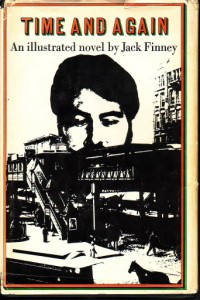Time and Again (novel)

First edition cover
|
|
| Author | Jack Finney |
|---|---|
| Country | United States |
| Language | English |
| Genre | Science fiction novel |
| Publisher | Simon & Schuster |
|
Publication date
|
1970 |
| Media type | Print (Hardcover, Paperback) |
| Pages | 304 |
| ISBN | (first edition, hardcover) |
| OCLC | 84586 |
Time and Again is a 1970 illustrated novel by Jack Finney. The many illustrations in the book are real, though, as explained in an endnote, not all are from the 1882 period in which the actions of the book take place. It had long been rumored that Robert Redford would convert the book into a movie. The project has never come to fruition. In July 2012, it was announced that Lionsgate studios optioned the film rights to the novel, with Doug Liman set to direct and produce.
A sequel, From Time to Time (1995), was published during the final year of the author's life. The book left room for a third novel, apparently never written.
In November 1970, Simon Morley, an advertising sketch artist, is approached by U.S. Army Major Ruben Prien to participate in a secret government project. He is taken to a huge warehouse on the West Side of Manhattan, where he views what seem to be movie sets, with people acting on them. It seems this is a project to learn whether it is feasible to send people back into the past by what amounts to self-hypnosis—whether, by convincing oneself that one is in the past, not the present, one can make it so.
As it turns out, Simon (usually called Si) has a good reason to want to go back to the past—his girlfriend, Kate, has a mystery linked to New York City in 1882. She has a letter dated from that year, mailed to an Andrew Carmody (a fictional minor figure who was associated with Grover Cleveland). The letter seems innocuous enough—a request for a meeting to discuss marble—but there is a note which, though half burned, seems to say that the sending of the letter led to "the destruction by fire of the entire World", followed by a missing word. Carmody, the writer of the note, mentioned his blame for that incident. He then killed himself.
Si agrees to participate in the project, and requests permission to go back to New York City in 1882 in order to watch the letter being mailed (the postmark makes clear when it was mailed). The elderly Dr. E.E. Danziger, head of the project, agrees, and expresses his regret that he can't go with Si, because he would love to see his parents' first meeting, which also occurred in New York City in 1882. The project rents an apartment at the famous Dakota apartment building, which did not actually exist in 1882. (It was completed two years later, but Finney explains that he took a few liberties with the timeline due to his fascination with the building.) Si uses the apartment as both a staging area and a means to help him with self-hypnosis, since the building's style is so much of the period in which it was built and faces a section of Central Park which, when viewed from the apartment's window, is unchanged from 1882.
...
Wikipedia
